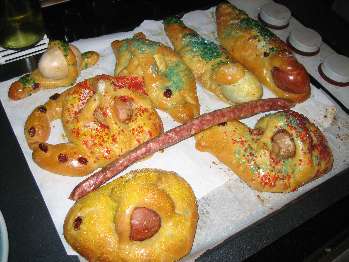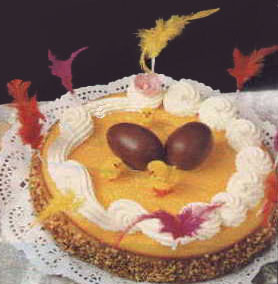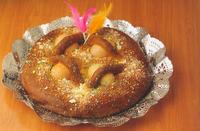Articles
21 March 2008
La mona de Pascua
Spring is already here!
Ours newly anticipated clocks have said goodbye to winter and many of us still do have in our mouths the flavor of chocolate that, every year, in the shape of Mona, egg or rabbit, delights kids and parents.
Pagan origins.
Many civilizations across the history, have celebrated the spring equinox as a time of renovation, with parties in glory of the goddesses of the fertility as Eastre (Saxony), Aphrodite (Cyprus), Astarte (Phoenicia), Remeter (Micenas), Hathor (Egypt), Ishtar (Assyria) … long before the arrival of Christianity.
Rabbits were the most powerful symbols of fecundity and, eggs, the beginning of life.
Hindus thought the world had born from an egg and in the Egyptian mythology eggs was especially important, since Bird Phoenix was burned in his nest and reborned later from the egg that had created it in the beginning.
Persians and Celtics celebrated also the spring equinox giving painted eggs as a sign of friendship.
During the Middle Ages it was usual to colour and to decorate eggs with luminous and strong colours representing the light of the spring Sun. They were bathing in liquid wax as protective cover and method of conservation. This practice derived in their ornamentation using natural colourings: leaves of spinach and petals of anemones to obtain the green one, the downy outbreak of the gorse for the yellow one, beetroot for a fabulous purple,,, (1).
Pope Julio III in the 16th century prohibited the consumption of eggs during the Lent promoting them in Sunday of Easter, giving place to a celebration in which eggs became to be the sign of Christ's revival: the Resurrection.
The first chocolate eggs were made in France and Germany during the 19th century using moulds made of tin-plate of handcrafted form.
Monas.
Easter Monas, so traditional in Catalonia, Valencia and Murcia, are the presentation of the classic eggs of Easter, made of chocolate or candy, with a cake as base, or on a construction of chocolate.
Etymologically, Mona would derive from Munna, Arabic term that means foodstuff, a gift Moriscos made to their Sirs. It is curious to verify that in the dictionary Gazophylacivum Catalano-Latinum. by Joan Lacavallería, published in Barcelona in the year 1696, mona has a purely zoological definition (monkey), but the Dictionary of the Castilian language, of the Royal Academy offers in the edition of 1783 the following definition: " Valencia and Murcia. The cake or coil that is cooked in the oven with eggs put in it with rind during Easter, also known as” hornazo " (1).
Originally it was a cake elaborated with mass of bread enriched with eggs, oil and herbs, with form of coil, doll or animals (lamb, hen, fish, snake …) that women, In the 16th century, elaborated after the Lent, placing a hard-boiled egg in the middle, with two strips of mass of bread in cross to prevent it from jumping out while cooking.
The first written reference is from the 15th century when Rois de Corella composed the Cantic to Holly Virgin, saying:
Dejunes contra el satanás que us mina, ara pasta, amb Déu la dolça mona
In the 18th century, it was already the classic gift from godfather to his godsons, and the number of eggs was corresponding to the years of age of the children up to coming to twelve. In this moment, maybe as final point of this gift, the number of eggs was rising up to thirteen. The tart known as coca of Easter, could re-dress diverse forms of animals or objects, like it happened in France with pains d'épice.
In the middle of 19th century, the Mona its initial simplicity and became more complicated, prospering with a few adornments of caramelized sugar, sugary almonds, jams…and eggs with Easter, all this crowned by figures of porcelain, wood, carton or fabrics. At the end of 19th century chocolate eggs started to de done with moulds brought from France. Soon, the whole cake became of chocolate due to the big possibilities to realize the most varied figures. This way, the rural tradition had turned into an urban tradition.
In other Spanish regions it is possible to find similar traditions like the "hornazos" sweet or salted, from Castilla or Andalucia (2)(3), or "the Bollu": in Asturias, a gift from godfathers to their godsons, a coil of puff-pastry refills and adorned with yolk of egg, though new tastes, have been introducing tarts with figures and eggs of chocolate.
Tradition has been kept to the present day and today it has turned into a sample of the artistic abilities of the pastrycooks who elaborate real artworks of chocolate, the majority with infantile motives, some characters of comics or tales fashionable.
Eggs, snails, fishes, chicks, rabbits, little houses…
Back to childhood for all, the equinoctial renovation at least in the spirit.
Dra. Laura Gosalbo
March 2008
(1)Our things of every day,
Charles Panati
The most valuable eggs were handcrafted by the great goldsmith Peter Carl Fabergé, who belonged entrusted by Alexander III of Russia as a present for his wife, Maria Feodorovna. The Fabergé's first egg, presented in 1886, had six centimeters of length and it) had a deceitfully simple exterior But inside there was a golden yolk that, once opened, was revealing a hen also of gold which eyes were rubies. The hen could be opened in turn raising the beak and within it a tiny reproduction was staying to the overdraft in brilliant of the imperial wreath. An even smaller ruby was hanging of this wreath. Forty three of fifty three eggs that supposedly this artist produced are nowadays in museums or form a part of private collections.
(2) http://www.hornazodesalamanca.org/
(3) Además de los hornazos de Salamanca y Avila en Castilla-León, son conocidas las monas saladas de Castellón y Teruel, también a la manera de empanadas de carne (lomo de cerdo y longaniza típicamente conservados en aceite desde las matanza) y huevo duro.
Hornazo de Córdoba (dulce) en las localidades de Fernán Nuñez, Priego, Villanueva del Duque, etc. y en general en casi toda Andalucía (Granada, Olvera de Cádiz, Úbeda, Torreperogil (Jaén)...
En Castilla-la Mancha, tenemos por ejemplo el hornazo de Santa Cruz de la Zarza (en Toledo) que es dulce y el Hornazo de Jueves lardero de Albacete que es salado.

Chocolate "mona"

Traditional "monas" in different shapes and sizes
, courtesy of Yolanda Ruíz.

"Mona" Barcelona style

"Mona" Valencia style
> BackOurs newly anticipated clocks have said goodbye to winter and many of us still do have in our mouths the flavor of chocolate that, every year, in the shape of Mona, egg or rabbit, delights kids and parents.
Pagan origins.
Many civilizations across the history, have celebrated the spring equinox as a time of renovation, with parties in glory of the goddesses of the fertility as Eastre (Saxony), Aphrodite (Cyprus), Astarte (Phoenicia), Remeter (Micenas), Hathor (Egypt), Ishtar (Assyria) … long before the arrival of Christianity.
Rabbits were the most powerful symbols of fecundity and, eggs, the beginning of life.
Hindus thought the world had born from an egg and in the Egyptian mythology eggs was especially important, since Bird Phoenix was burned in his nest and reborned later from the egg that had created it in the beginning.
Persians and Celtics celebrated also the spring equinox giving painted eggs as a sign of friendship.
During the Middle Ages it was usual to colour and to decorate eggs with luminous and strong colours representing the light of the spring Sun. They were bathing in liquid wax as protective cover and method of conservation. This practice derived in their ornamentation using natural colourings: leaves of spinach and petals of anemones to obtain the green one, the downy outbreak of the gorse for the yellow one, beetroot for a fabulous purple,,, (1).
Pope Julio III in the 16th century prohibited the consumption of eggs during the Lent promoting them in Sunday of Easter, giving place to a celebration in which eggs became to be the sign of Christ's revival: the Resurrection.
The first chocolate eggs were made in France and Germany during the 19th century using moulds made of tin-plate of handcrafted form.
Monas.
Easter Monas, so traditional in Catalonia, Valencia and Murcia, are the presentation of the classic eggs of Easter, made of chocolate or candy, with a cake as base, or on a construction of chocolate.
Etymologically, Mona would derive from Munna, Arabic term that means foodstuff, a gift Moriscos made to their Sirs. It is curious to verify that in the dictionary Gazophylacivum Catalano-Latinum. by Joan Lacavallería, published in Barcelona in the year 1696, mona has a purely zoological definition (monkey), but the Dictionary of the Castilian language, of the Royal Academy offers in the edition of 1783 the following definition: " Valencia and Murcia. The cake or coil that is cooked in the oven with eggs put in it with rind during Easter, also known as” hornazo " (1).
Originally it was a cake elaborated with mass of bread enriched with eggs, oil and herbs, with form of coil, doll or animals (lamb, hen, fish, snake …) that women, In the 16th century, elaborated after the Lent, placing a hard-boiled egg in the middle, with two strips of mass of bread in cross to prevent it from jumping out while cooking.
The first written reference is from the 15th century when Rois de Corella composed the Cantic to Holly Virgin, saying:
Dejunes contra el satanás que us mina, ara pasta, amb Déu la dolça mona
In the 18th century, it was already the classic gift from godfather to his godsons, and the number of eggs was corresponding to the years of age of the children up to coming to twelve. In this moment, maybe as final point of this gift, the number of eggs was rising up to thirteen. The tart known as coca of Easter, could re-dress diverse forms of animals or objects, like it happened in France with pains d'épice.
In the middle of 19th century, the Mona its initial simplicity and became more complicated, prospering with a few adornments of caramelized sugar, sugary almonds, jams…and eggs with Easter, all this crowned by figures of porcelain, wood, carton or fabrics. At the end of 19th century chocolate eggs started to de done with moulds brought from France. Soon, the whole cake became of chocolate due to the big possibilities to realize the most varied figures. This way, the rural tradition had turned into an urban tradition.
In other Spanish regions it is possible to find similar traditions like the "hornazos" sweet or salted, from Castilla or Andalucia (2)(3), or "the Bollu": in Asturias, a gift from godfathers to their godsons, a coil of puff-pastry refills and adorned with yolk of egg, though new tastes, have been introducing tarts with figures and eggs of chocolate.
Tradition has been kept to the present day and today it has turned into a sample of the artistic abilities of the pastrycooks who elaborate real artworks of chocolate, the majority with infantile motives, some characters of comics or tales fashionable.
Eggs, snails, fishes, chicks, rabbits, little houses…
Back to childhood for all, the equinoctial renovation at least in the spirit.
Dra. Laura Gosalbo
March 2008
(1)Our things of every day,
Charles Panati
The most valuable eggs were handcrafted by the great goldsmith Peter Carl Fabergé, who belonged entrusted by Alexander III of Russia as a present for his wife, Maria Feodorovna. The Fabergé's first egg, presented in 1886, had six centimeters of length and it) had a deceitfully simple exterior But inside there was a golden yolk that, once opened, was revealing a hen also of gold which eyes were rubies. The hen could be opened in turn raising the beak and within it a tiny reproduction was staying to the overdraft in brilliant of the imperial wreath. An even smaller ruby was hanging of this wreath. Forty three of fifty three eggs that supposedly this artist produced are nowadays in museums or form a part of private collections.
(2) http://www.hornazodesalamanca.org/
(3) Además de los hornazos de Salamanca y Avila en Castilla-León, son conocidas las monas saladas de Castellón y Teruel, también a la manera de empanadas de carne (lomo de cerdo y longaniza típicamente conservados en aceite desde las matanza) y huevo duro.
Hornazo de Córdoba (dulce) en las localidades de Fernán Nuñez, Priego, Villanueva del Duque, etc. y en general en casi toda Andalucía (Granada, Olvera de Cádiz, Úbeda, Torreperogil (Jaén)...
En Castilla-la Mancha, tenemos por ejemplo el hornazo de Santa Cruz de la Zarza (en Toledo) que es dulce y el Hornazo de Jueves lardero de Albacete que es salado.

Chocolate "mona"

Traditional "monas" in different shapes and sizes
, courtesy of Yolanda Ruíz.

"Mona" Barcelona style

"Mona" Valencia style





